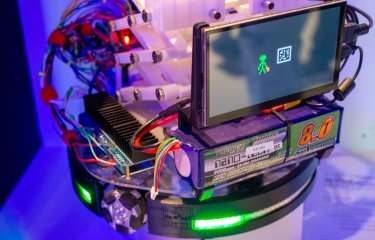An interview with Carlos Lima Santana, Digital Product Designer at British Airways
16 June 2023

Carlos Lima Santana is a senior product designer and user experience (UX) design expert. With over a decade of experience in consultancy, in-house and creative agency environments, he is a Digital Product Designer at British Airways – and a tutor on our online MA in User Experience Design.
Alongside his technical expertise, Carlos is passionate about mentoring. In his role as a tutor, he uses his wealth of industry experience to develop, support and empower the next generation of designers. We chatted with him about his passion for the industry and what he thinks it takes to make it as a UX designer.
Coming from an industrial design background, when did you first become passionate about UX design?
Initially, my primary passion was focused on graphic design. Coming from Brazil, I was fortunate to pursue an integrated industrial and graphic design degree program at a local university. Digital strategy methods were still relatively nascent there and then — it wasn't until the mid-2000s that it matured into a thriving industry. As companies began to recognise the significance of user experience and the advantages of integrating their requirements into product development processes, my curiosity was piqued.
As a very empathetic person, I appreciate how UX designers incorporate empathy and understanding into their work. The process of identifying and solving user struggles during their journey is a driving force for me. Throughout my career, I have found that projects involving direct interaction with end users have been the most fulfilling.
I have a deep appreciation for design because no matter the sector, the fundamental goal remains: to satisfy people's needs by creating objects, digital artefacts, or experiences that surpass their expectations.
Can you tell us about a professional project you’re particularly proud of?
During my time as a freelancer, I had the opportunity to participate in an education project for Descomplica, a Brazilian education start-up that has now evolved into a digital university. Our goal was to provide support for students as they prepared for the university entrance exams, which are a significant part of the local academic landscape. As a UX designer, I was accustomed to working with visual screens and layouts, but this project was different — it was a partnership that involved creating a voice-activated tool compatible with the Google Assistant platform. This tool was designed to make exam preparation more accessible for students, and it was my first time working in the field of conversational design.
The fact that it had a conversational interface meant it was usable in a wide range of situations where using a phone’s visual features wouldn’t be possible. It was one of the first pieces of voice software to be created for that platform in Brazil – which is commonplace now with voice assistants on most devices – so it was a great project to be part of at that early stage.
The place where designers can make a difference in the world is at the table where those strategic decisions are made — that’s where change happens, and that is precisely what our master’s equips people to do.
What is the most important skill UX designers need to succeed in the industry?
Being a critical and reflective practitioner is crucial for success in any field. It's about more than just possessing technical skills, although they are obviously essential. With the constant changes in industry-standard software, it's critical to have a tech-proof skillset that enables you to develop effective problem-solving strategies regardless of the systems you're using. Additionally, disruptive technical developments are rapidly emerging, making it even more vital to have the capacity to adapt and innovate. While software can produce ready-made solutions, humans can reflectively integrate a wide range of elements and connect them to make meaningful improvements. This skill cannot be easily automated.
At Falmouth, we offer a master's program that teaches individuals how to incorporate AI into their toolbox instead of fearing it. The creative industries are well-suited to adopting AI into their process, as they have a history of adapting and transforming their method with the times. I’m sure some of the first graphic artists to use computers in their practice were initially hesitant but soon recognised that it complemented their techniques instead of replacing them.
What do you most enjoy about being an online tutor at Falmouth?
I really enjoy seeing the diverse experiences that students bring to the course and how willing they are to share them with the community. It's remarkable how close-knit the community is, despite spanning different time zones. As a professional in the industry, it's refreshing to see students' unique approaches to ideation and problem-solving. It's great that they have time to explore and experiment.
Our student body is diverse and includes individuals with backgrounds in various design fields, such as graphic, fashion or content design. These backgrounds prove to be valuable assets in the field of UX design. The beauty of working in UX design is that you have a wealth of perspectives to draw from within your team when tackling projects.
Our industry benefits greatly from the diverse and complex online community. UX design revolves around the experiences of others, so having a rich community leads to better outcomes. Digital experiences vary significantly across the globe, and it's essential to consider technological access and the underlying cultural differences in interacting with technology. Returning to the project I mentioned earlier, in some areas of the world, it may not always be safe to use your phone in public, making voice-activated experiences more significant in these contexts. This highlights the importance of a global collaborative community of emerging UX designers.
Something else I love about it is how thirsty for knowledge the students are, and being able to play a part in equipping them with the depth of expertise that the industry so badly needs. At British Airways, I am part of a growing product team looking after the end-to-end digital experience for our customers, and we have some absolutely talented product designers and researchers on board. Like many other design teams out there, we are always actively looking for new talent and receive many applications from individuals who have gained technical software skills from completing short courses. However, only a select few can showcase their ability to think strategically about the future of the industry, and this is a skill that is in very high demand. The place where designers can make a difference in the world is at the table where those strategic decisions are made — that’s where change happens, and that is precisely what our master’s equips people to do.
Please note that Carlos is no longer working for Falmouth University.




